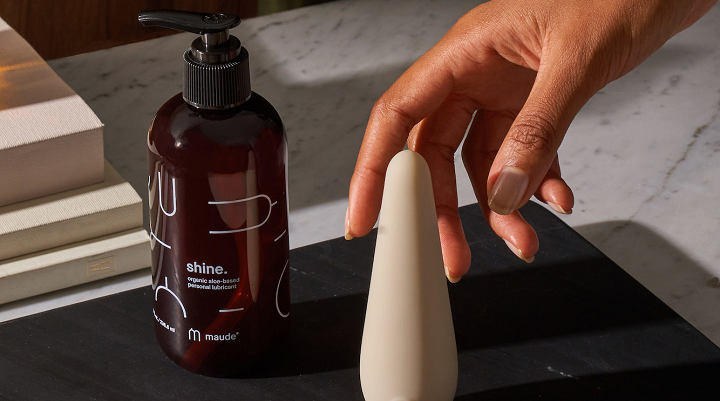When you walk into a beauty store, you expect to find a wide array of makeup powders, hair curlers, and setting sprays. But what about products like massage candles, vibrators, and lubricants? In recent years, these and other sexual wellness products have been popping up on the physical and virtual shelves of many mainstream beauty retailers, such as Sephora and Ulta Beauty. Last September, Ulta Beauty added an intimate wellness section to its ‘Wellness Shop’, a segment dedicated to
ed to self-care and health-related products. And this March, Maude became the first sexual wellness brand to be carried in Sephora’s bricks-and-mortar stores.
Other mainstream retailers that have added intimate care divisions in the past few years include Bluemercury, Neiman Marcus, Nordstrom, and Bergdorf Goodman.
On the flip side, sexual wellness brands, like Lelo, have also begun leaning into the beauty category by launching their own cosmetic lines.
So, why have these seemingly disparate retail categories start to merge together, and what do they have in common?
The current state of the sexual wellness market
According to a market research study published by Zion Market Research, the global sexual wellness market size was worth around (US$57.5 billion) in 2022 and is predicted to grow to around (US$110.33 billion) by 2030 with a compound annual growth rate (CAGR) of roughly 8.49 per cent during the forecast period 2023-2030.
There are several factors behind this growth, which in turn, has driven the integration of sexual wellness products into beauty retail.
One major factor was the pandemic and consumers’ increased interest in self-care products, including sexual wellness items, during this time. With limited opportunities for physical interaction and heightened levels of financial, physical, and emotional stress, many consumers turned to sexual wellness products as a form of rest and relaxation.
Wow Tech Group, which owns sex toy brands We-Vibe and Womanizer, reported that online sales for both brands were 200 per cent higher in April 2020 compared to the previous year, while sex toy retailer Adam and Even reported a 30 per cent year-on-year increase in online sales in March and April 2020.
Penny Coy, Ulta Beauty’s vice president of merchandising, explained that sexual wellness products have become another avenue of self care for the consumers, in the same way that makeup and skincare items have traditionally been.
“Sexual health was once considered a taboo topic across the retail industry and we’ve seen increased acceptance of the category, alongside a deeper connection between intimacy and overall wellbeing in recent years,” she said.
“In recent years, we’ve continued to see our guests invest in self-care alongside beauty to not only look their best, but also feel their best. Our guests closely connect intimate wellness to holistic wellbeing – whether they are looking to enhance their intimate experience with oils, lubricants, devices, and suppositories, or nurture their care for ‘down there’ with pH-balancing cleansers, wipes, aftercare, and supplements.”
As Coy pointed out, conversations about sexual wellness were traditionally hushed, but nowadays, many Millennial and Gen Z women speak openly about topics like periods, perimenopause, and menopause.
A report from business analytics company Future Market Insights disclosed that the women’s intimate care products market is estimated to reach (US$28.88 billion) in 2023 and (US$43 billion) by 2023. Currently, women’s intimate care products account for an approximately 19 per cent share of the global skincare market.
Sexual wellness blends into the beauty industry
Aside from beauty retailers integrating sexual wellness products into their offerings, the sexual wellness industry has been dipping a toe into the world of cosmetic products.
In June, Swedish sex toy and message brand Lelo launched its own beauty line dubbed Lelo Makeup. Currently, the brand offers liquid lipstick and tube lipstick formulations.
Lelo’s chief marketing officer Luka Matutinovic concurred with Ulta Beauty’s statement and added that the sexual wellness category — like the beauty category — flourishes upon the concept of self-expression.
“The beauty world, and especially makeup, thrives on uninhibited self-expression and inspires experimentation, much like the world of sexual wellness. But, there is an even more inherent link than it might seem at first glance,” Matutinovic said.
“The common denominator between beauty and sexual wellness is self-love. Self-love in its turn boosts confidence. Applying a bold shade of lipstick, for example, boosts confidence, calls on our creativity makes a bold statement, and makes you look like a million bucks. And it was for this reason that we have decided to enrich our portfolio of products and delve into beauty.”
What’s next?
Looking ahead, sexual wellness products are likely to become even more prevalent in the beauty industry, with further integration into relatively untapped spaces, such as fragrance.
In July, consumer trend analytics firm Spate revealed that “pheromone perfume” was one of the highest trending search terms in the fragrance industry, with searches for the term increasing by 115.7 per cent year-over-year. Over 20.4 per cent growth is predicted in the next 12 months.
Fragrance brands like Marilyn Miglin and Pure Instinct are currently leading in this trend.
Collaborations are likely to increase in the future as well, in the vein of the partnership between beauty brand Pacifica and sexual wellness brand Lola. Last December, they created a bundle package including reusable eye and brow masks along with ultra-thin latex condoms.
The beauty industry has long employed tongue-in-cheek marketing campaigns — think Nars Cosmetics’ “Orgasm” collection or Too Faced Cosmetics’ “Better Than Sex” mascara. Now, it can address the topic of sexual wellness in more directly — and reach a new audience of open-minded consumers in the process.

